
A team of paleontologists of the Institute of Geology and Paleontology (including a former CGD junior member Valéria Vaškaninová) together with their colleagues from other institutions described a 465 Ma old trilobite Bohemolichas with preserved gut contents in Nature. The trilobite is among the first Czech fossils that were examined at the European Synchrotron facility in Grenoble. This cutting-edge technology enabled to non-destructively visualise all fragments in the gut of the trilobite, some of them identifiable to the species level, at a high resolution. The digestive tract of the trilobite was tightly packed with calcareous shells and their fragments that belonged to marine invertebrates such as ostracods, bivalves and echinoderms. The authors propose that the trilobite was an opportunistic scavenger, a light crusher and a chance feeder that ate dead or living animals, which either disintegrated easily or were small enough to be swallowed whole, without any attempt to reject the hard shells. This indicates that they were not exposed to an acidic environment, similar as in modern marine crustaceans and horseshoe crabs, suggesting that it might be an ancestral character of arthropods. The research thus fills a fundamental gap in our understanding of trilobite ecology and their role in Paleozoic ecosystems.
Kraft P., Vaškaninová V., Mergl M., Budil P., Fatka O., Ahlberg P.E. (2023): Uniquely preserved gut contents illuminate trilobite palaeophysiology. Nature (DOI)









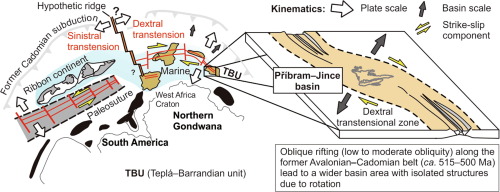
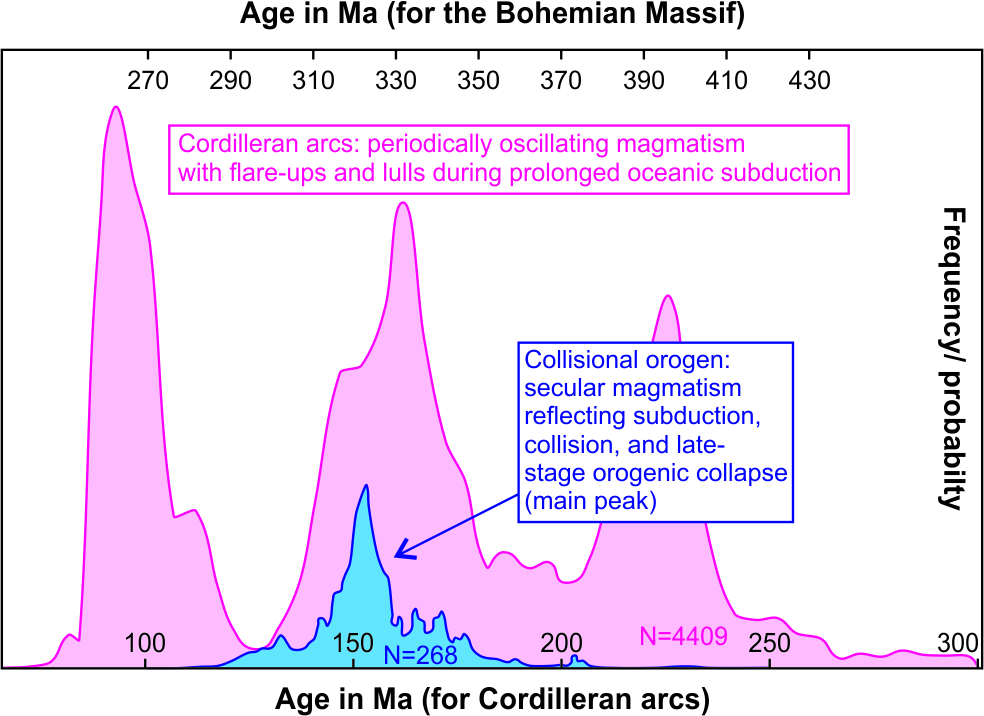 A new paper by Trubač et al. combines geochronologic data with a GIS-based spatial analysis of plutons in the Bohemian Massif, Variscan belt, to examine the magma fluxes and temporal pattern of plutonism during collisional orogeny. The collisional orogens differ from continental margin arcs, where the plutonic material is added in repeating cycles to the upper crust during protracted oceanic subduction. Instead, it was shown that the collisional plutonism reflects a secular thermotectonic evolution of the orogen, where magma sources change from mantle-dominated to intracrustal, paralleled by increasing significance of crustal recycling at the expense of crustal growth. The analysis also suggests that crustal thickening, commonly regarded as the main cause of plutonism in collisional orogens, may be of relatively lower significance than a late-stage mantle delamination.
A new paper by Trubač et al. combines geochronologic data with a GIS-based spatial analysis of plutons in the Bohemian Massif, Variscan belt, to examine the magma fluxes and temporal pattern of plutonism during collisional orogeny. The collisional orogens differ from continental margin arcs, where the plutonic material is added in repeating cycles to the upper crust during protracted oceanic subduction. Instead, it was shown that the collisional plutonism reflects a secular thermotectonic evolution of the orogen, where magma sources change from mantle-dominated to intracrustal, paralleled by increasing significance of crustal recycling at the expense of crustal growth. The analysis also suggests that crustal thickening, commonly regarded as the main cause of plutonism in collisional orogens, may be of relatively lower significance than a late-stage mantle delamination.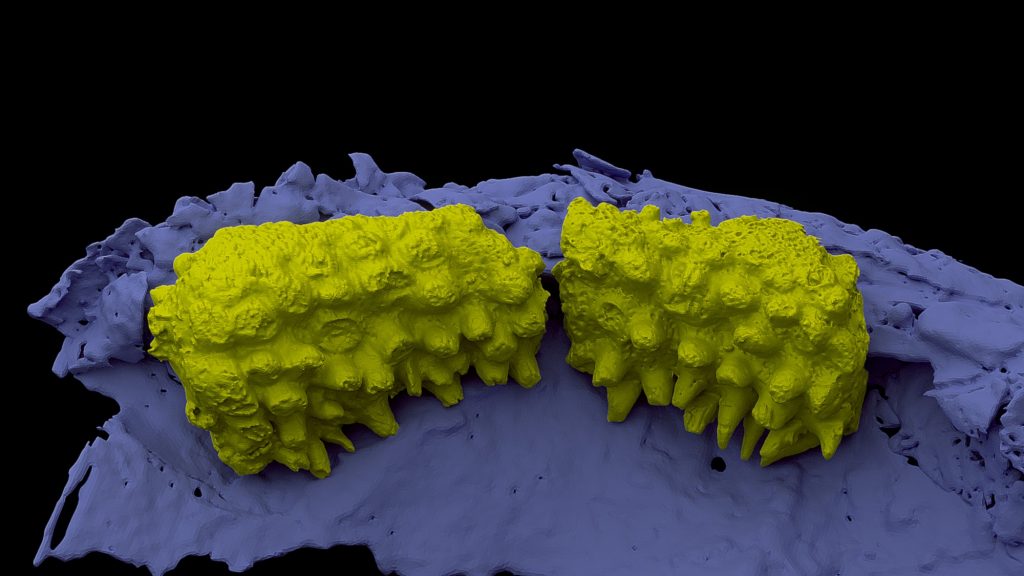 In the two extant jawed vertebrate groups, bony fish (and their descendants the land animals) and sharks, new teeth usually develop on the inner side of the old ones. Sharks have no bones and their teeth do not attach to the cartilaginous jaws, whereas in bony fish and land animals, the teeth are always attached to jaw bones. This diversity raises many questions about the origin of teeth. Until now, researchers have focused on fossils of a group of armoured fish, the arthrodires, the only stem jawed vertebrates in which teeth were known. They struggled to understand how they could have evolved into the teeth of modern vertebrates, as arthrodire teeth are so different in position and mode of tooth addition.
In the two extant jawed vertebrate groups, bony fish (and their descendants the land animals) and sharks, new teeth usually develop on the inner side of the old ones. Sharks have no bones and their teeth do not attach to the cartilaginous jaws, whereas in bony fish and land animals, the teeth are always attached to jaw bones. This diversity raises many questions about the origin of teeth. Until now, researchers have focused on fossils of a group of armoured fish, the arthrodires, the only stem jawed vertebrates in which teeth were known. They struggled to understand how they could have evolved into the teeth of modern vertebrates, as arthrodire teeth are so different in position and mode of tooth addition.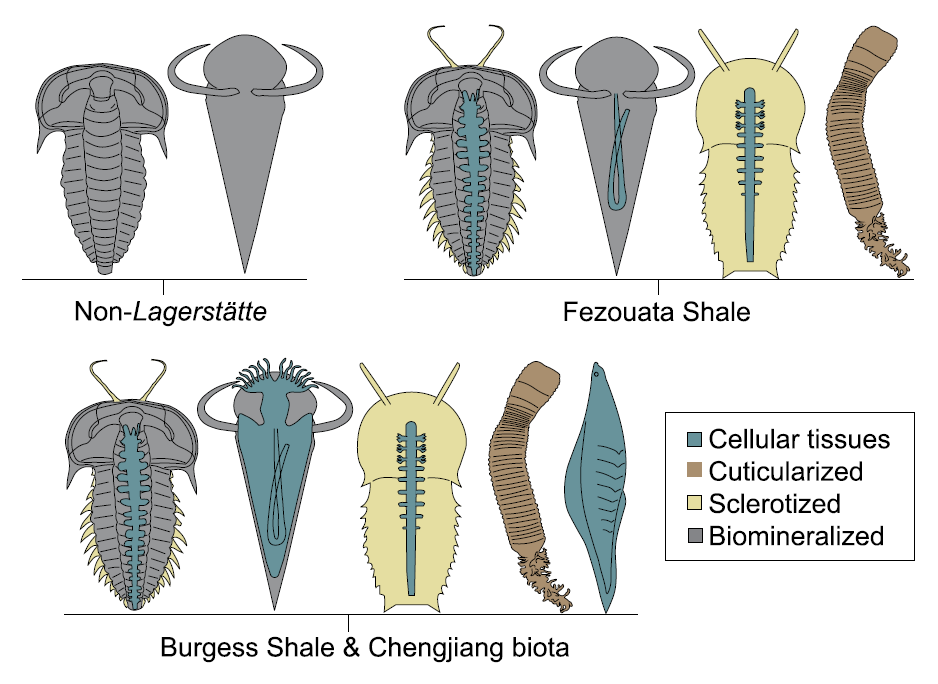 Exceptionally preserved fossils provide deep insight into early animal evolution. For example, the step by step evolution of morphological innovations that ultimately led to the origin of many recent animals was achieved using information from such exceptionally preserved fossils. Each of these sites with exceptional preservation – so-called Lagerstätten – is, however, a subject of specific fossilization bias. This means that at different fossil sites different information is lost during the fossilization process. To understand such information loss is especially important once we want to compare fossils from different sites and infer some general trends. Without knowing fossilization biases, we may end-up comparing apples and oranges. A new study by Saleh et al. (Lukáš Laibl as a co-author) tried to understand such biases. It compared three well known lower Paleozoic Lagerstätten – the Burgess Shale (ca. 505 million years old, Canada), the Chengjiang Biota (ca. 530 million years old, China) and the Fezouata Shale (ca. 479-478 million years old, Morocco). Interestingly, the Fezouata Shale is different from both Burgess and Changjiang. In Fezouata Shale, the soft parts of animals are most commonly associated with partially mineralized and sclerotized tissues. The digestive tract is, for example, preserved mostly in fossils with hard biomineralized exoskeletons (such as in trilobites and echinoderms). For the same reason, the entire soft animals are not preserved in Fezouata Shale. Indeed, most of the animals from Fezouata Shale were either biomineralized (trilobites, echinoderms, gastropods, brachiopods), sclerotized (many types of arthropods) or have had at least external cuticle (various “worms”). On the other hand, Burgess and Changjiang commonly preserve entirely soft animals and also show a higher diversity of different tissue types in particular fossil species. So to sum up, the answer to the question in the title is – yes, but with caution. We have to differentiate between fossilization absence and real absence. Many animals could have lived in the Fezouata Shale environment but were nor preserved because of the nature of the fossilization process. This is likely the case for early chordates that were entirely soft-bodied. On the other hand, the absence of penis worms (priapulids) in the Fezouata Shale is most probably a real aspect of the fauna, since these cuticle-bearing animals would “survive” the fossilization process.
Exceptionally preserved fossils provide deep insight into early animal evolution. For example, the step by step evolution of morphological innovations that ultimately led to the origin of many recent animals was achieved using information from such exceptionally preserved fossils. Each of these sites with exceptional preservation – so-called Lagerstätten – is, however, a subject of specific fossilization bias. This means that at different fossil sites different information is lost during the fossilization process. To understand such information loss is especially important once we want to compare fossils from different sites and infer some general trends. Without knowing fossilization biases, we may end-up comparing apples and oranges. A new study by Saleh et al. (Lukáš Laibl as a co-author) tried to understand such biases. It compared three well known lower Paleozoic Lagerstätten – the Burgess Shale (ca. 505 million years old, Canada), the Chengjiang Biota (ca. 530 million years old, China) and the Fezouata Shale (ca. 479-478 million years old, Morocco). Interestingly, the Fezouata Shale is different from both Burgess and Changjiang. In Fezouata Shale, the soft parts of animals are most commonly associated with partially mineralized and sclerotized tissues. The digestive tract is, for example, preserved mostly in fossils with hard biomineralized exoskeletons (such as in trilobites and echinoderms). For the same reason, the entire soft animals are not preserved in Fezouata Shale. Indeed, most of the animals from Fezouata Shale were either biomineralized (trilobites, echinoderms, gastropods, brachiopods), sclerotized (many types of arthropods) or have had at least external cuticle (various “worms”). On the other hand, Burgess and Changjiang commonly preserve entirely soft animals and also show a higher diversity of different tissue types in particular fossil species. So to sum up, the answer to the question in the title is – yes, but with caution. We have to differentiate between fossilization absence and real absence. Many animals could have lived in the Fezouata Shale environment but were nor preserved because of the nature of the fossilization process. This is likely the case for early chordates that were entirely soft-bodied. On the other hand, the absence of penis worms (priapulids) in the Fezouata Shale is most probably a real aspect of the fauna, since these cuticle-bearing animals would “survive” the fossilization process.
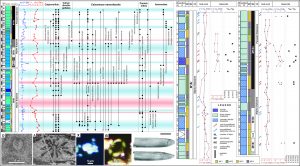 A unique exposure of the Štramberk Limestone in the Kotouč quarry was investigated by multidisciplinary approaches to clarify the age and paleoenvironmental conditions. Integrated stratigraphy (magnetostratigraphy, 87Sr/86Sr isotopes from belemnites, δ18O and δ13C stable isotopes from bulk rock, microfossil and ammonite assemblages) revealed an early Berriasian age and refused the presence of the Jurassic/Cretaceous boundary interval. The δ18O isotope signal from bulk rock together with microfossils distribution (calpionellids, calcareous nannofossils) show temperature oscillations throughout the studied successions. Boreal influences were detected by ammonites, supporting also climatic variations within the earliest Cretaceous. The limestone microfacies then revealed that all parts of a carbonate reef have been preserved in the quarry: slope, platform margin reefs, sand shoals, and possibly also patch-reefs in the inner platform.
A unique exposure of the Štramberk Limestone in the Kotouč quarry was investigated by multidisciplinary approaches to clarify the age and paleoenvironmental conditions. Integrated stratigraphy (magnetostratigraphy, 87Sr/86Sr isotopes from belemnites, δ18O and δ13C stable isotopes from bulk rock, microfossil and ammonite assemblages) revealed an early Berriasian age and refused the presence of the Jurassic/Cretaceous boundary interval. The δ18O isotope signal from bulk rock together with microfossils distribution (calpionellids, calcareous nannofossils) show temperature oscillations throughout the studied successions. Boreal influences were detected by ammonites, supporting also climatic variations within the earliest Cretaceous. The limestone microfacies then revealed that all parts of a carbonate reef have been preserved in the quarry: slope, platform margin reefs, sand shoals, and possibly also patch-reefs in the inner platform.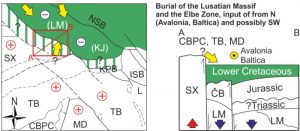 Since the pioneering works of early 20th century, Late Cretaceous sandstones along the Lusatian Fault were interpreted as sourced from the West Sudetic Island. However, the original concept that basement of the Lusatian Block directly supplied a clastic material to the Late Cretaceous shores and deltas, has been recently challenged. New LA-ICP-MS U–Pb dating of detrital zircons and heavy mineral analysis of Permian, Jurassic, and Upper Cretaceous formations revealed diachronous basin formation and subsequent inversion by reactivation of major faults in the northern Bohemian Massif. In turn, the Middle Jurassic–Early Cretaceous sedimentary cover of the Lusatian Block was redeposited by its later uplift and unroofing. This paper proves that the Bohemian Creatceous Basin is not only an excellent archive of paleoclimate changes, but its record may contribute to deciphering relatively enigmatic post-early Permian tectonosedimentary history of the surrounding basement areas.
Since the pioneering works of early 20th century, Late Cretaceous sandstones along the Lusatian Fault were interpreted as sourced from the West Sudetic Island. However, the original concept that basement of the Lusatian Block directly supplied a clastic material to the Late Cretaceous shores and deltas, has been recently challenged. New LA-ICP-MS U–Pb dating of detrital zircons and heavy mineral analysis of Permian, Jurassic, and Upper Cretaceous formations revealed diachronous basin formation and subsequent inversion by reactivation of major faults in the northern Bohemian Massif. In turn, the Middle Jurassic–Early Cretaceous sedimentary cover of the Lusatian Block was redeposited by its later uplift and unroofing. This paper proves that the Bohemian Creatceous Basin is not only an excellent archive of paleoclimate changes, but its record may contribute to deciphering relatively enigmatic post-early Permian tectonosedimentary history of the surrounding basement areas. An intriguing example of a late Precambrian chert-graywacke mélange was explored by Jaroslava Hajná and colleagues in the central Bohemian Massif (mélanges are chaotic rock units that contain mixed exotic blocks and typically form along the active plate margins). A detailed field, geochronologic, and geochemical study revealed two types of chert (pelagic and those with a terrigenous component) that were mixed together during a large-scale submarine slide on an outer slope of oceanic trench. This case turned out as a quite unusual deep-marine succession and led to a definition of a new type of mélange. Published in a special issue of Gondwana Research devoted to the
An intriguing example of a late Precambrian chert-graywacke mélange was explored by Jaroslava Hajná and colleagues in the central Bohemian Massif (mélanges are chaotic rock units that contain mixed exotic blocks and typically form along the active plate margins). A detailed field, geochronologic, and geochemical study revealed two types of chert (pelagic and those with a terrigenous component) that were mixed together during a large-scale submarine slide on an outer slope of oceanic trench. This case turned out as a quite unusual deep-marine succession and led to a definition of a new type of mélange. Published in a special issue of Gondwana Research devoted to the  On Friday September, 27th, Filip Scheiner successfully defended his Ph.D. thesis entitled “Geochemical markers from foraminiferal tests as a tool for reconstruction of paleoceanological environments: a case study from the Miocene of the Central Paratethys” (advisor K. Holcová). His Ph.D. research resulted in four papers in highly ranked international journals. Filip will continue as a Junior Researcher affiliated with UNCE. Congratulations!
On Friday September, 27th, Filip Scheiner successfully defended his Ph.D. thesis entitled “Geochemical markers from foraminiferal tests as a tool for reconstruction of paleoceanological environments: a case study from the Miocene of the Central Paratethys” (advisor K. Holcová). His Ph.D. research resulted in four papers in highly ranked international journals. Filip will continue as a Junior Researcher affiliated with UNCE. Congratulations!